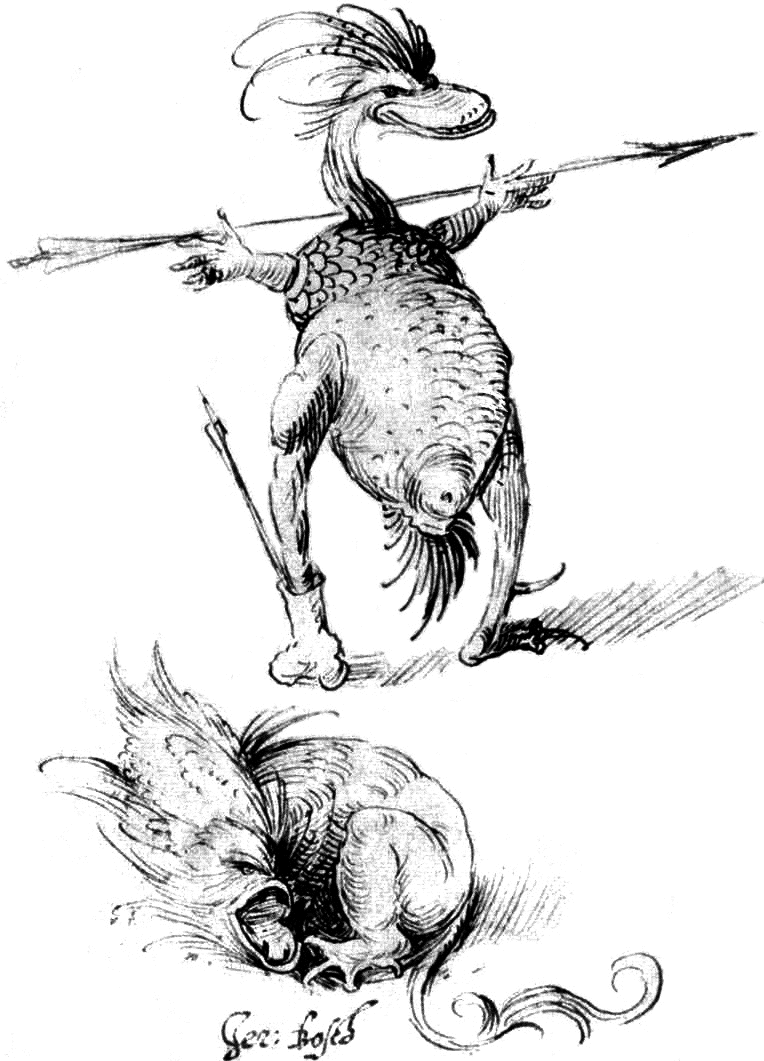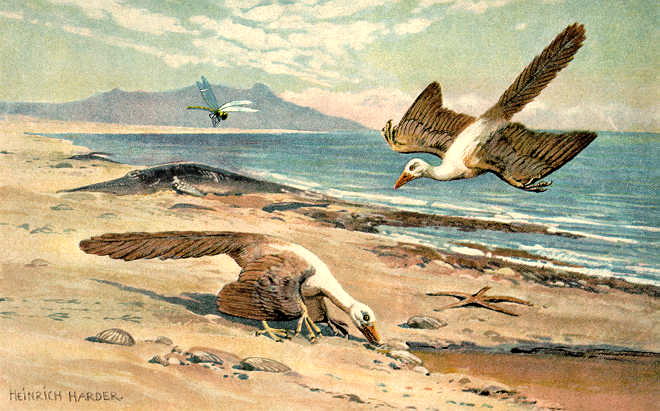I brake for wandering monsters

In old-school role-playing games, one of the things that strikes me—and hard—is that there is very little guidance to new players and especially new game masters on how to perform basic tasks related to the game. Solving that problem is one of the goals of The Adventure Guide’s Handbook.
When it comes to wandering monster charts, even the sprawling venerasity that is the Dungeon Masters Guide eschews instructions on making them, and just provides its own charts that include every monster in the Monster Manual plus a few. The only instructions on making your own were that if you wanted to add your own creatures you calculate the experience point values, correlate them to existing creatures, and insert them into the existing tables next to those existing creatures. Thus, every dungeon potentially includes every monster, and every unnamed city/town includes a full complement of harlots.
On its face, making a wandering monster table is as simple as making a table and putting monsters on it. Choosing the appropriate monsters to put on it, however, is a skill that, for me at least, took some time to learn. An area that has a unique flavor is more memorable, and random encounters contribute heavily to how players remember an area. Wandering monster tables shouldn’t just be an afterthought, nor should they be generic to the entire campaign world.
I have found it easiest to break encounter tables into two parts. I use a table of general categories of encounters that breaks out into tables of individual encounters. Here’s the example of a “general categories” table from the handbook:
| Percentage | Encounter | |
|---|---|---|
| 01-55 | Normal Animals | 55% |
| 56-75 | Fantastic Creatures | 20% |
| 76-90 | Natural Encounters | 15% |
| 91-98 | Humanoid Creatures | 8% |
| 99-00 | Civilized Folk | 2% |
The break out for Fantastic Creatures might look like:
| 01-20 | Giant Spider (2d4) | 20% |
| 21-30 | Undead | 10% |
| 31-40 | Dryad (1) | 10% |
| 41-50 | Rock Dryad (1) | 10% |
| 51-60 | Yeti (2d6) | 10% |
| 61-70 | Walking Tree (1d4) | 10% |
| 71-80 | Owl Dragon (Specific) | 10% |
| 81-90 | Green Dragon (Specific) | 10% |
| 91-95 | Living Light (1) | 5% |
| 96-00 | Chaotic Mist | 5% |
And the breakout for Natural Encounters might look like this for a particularly wet area:
| 01-25 | light storm (d100 hours) | 25% |
| 26-40 | fog (d20 yards visibility for d8 hours) | 15% |
| 41-50 | heavy storm (d40 hours) | 10% |
| 51-60 | river crosses path (3d6 feet deep) | 10% |
| 61-70 | thick foliage (d100 yards) | 10% |
| 71-79 | exceptionally cold (d6 days) | 9% |
| 80-87 | exceptionally warm (d6 days) | 8% |
| 88-95 | steep ravine blocks path (d100+100 yards deep) | 8% |
| 96-00 | quicksand (d8 yards diameter) | 5% |
But how to choose what categories go in the category table, and how to decide what individual encounters belong in the break-out tables?
Think about the area in general. Think about the kind of encounters you want for the feel of the adventures that exist here. Are Fantastic Creatures common? Rare? Is the area well-traveled by caravans, farmers, or brigands? Will they often be huddling in their tents from the damp mist or rolling thunderstorms, or seeking shelter from sandstorms or the blazing sun?

Is there a special category of encounters you want to focus on? Give them their own heading. Dinosaurs in a prehistoric valley, for example, or creatures of the Chaotic Mist in the mist. The rule of thumb is simple: are you thinking that 10% or more of all encounters need to be undead? Then there is an undead section in the list. On the other hand, if you just think, well, the undead are a fantastic encounter along with the others, then it does not need its own section.
And if, even if the category itself is rare, there are lots of creatures within that category, then it might still justify a position in the categories table, to make it clear that while these encounters are rare, you might see a whole new world once they’re encountered. Faerie encounters might fall into this category of rare but rich.
However you choose them, make a list of just those wide categories of encounters, and adjust the percentages. Some common categories are:
- Civilized peoples
- Animals
- Fantastic creatures
- Natural encounters
- Humanoid creatures
And, potentially, special categories dependent on the area, such as dinosaurs, aliens, chaotic mist encounters, masquerades, faerie, or dragons.
Assign percentages appropriate for the feel of the area. If it’s a fantastic area, there should be more fantastic encounters; if it’s mundane, more civilized creatures and/or animals, and if it’s wild, more natural encounters.
Then, start thinking about specific encounters.
Generally, I try to avoid having too many levels of tables.1 One for general categories of encounters and one for the encounters themselves is perfect. But if a group of encounters is rarer than can be modeled in one table, I’ll separate that off. Dragons, undead, and faeries often end up getting their own third-level tables in areas that are not infested by the creatures enough to warrant their own second-level table.
When looking at what’s in the area, look at your adventure.
- Are there any warring factions in the area? These are the most likely encounters, because they’re on patrol and paranoid.
- In the encounter key for the adventure, what creatures are mobile? What creatures are likely to investigate strange noises or prowl for victims?
- What natural features does this area have? Waterfalls, rivers, streams, and canyons, if common, are good natural obstacles to put in an encounter table.
- What mundane animal and plant life might constitute an encounter?
- What is the weather like? Any inclement weather goes into the natural encounters table.
- Who is traveling through this area? Do caravans pass through? Where are they from and where are they going?
The answer to those questions will fill out your specific encounter tables. If the table isn’t interesting enough yet, I’ll also look at nearby areas and see what kinds of things that live there might be passing through here. And, finally, I’ll glance through the environments section of the Encounter Guide, pulling out creatures that are common to the area as well as one or two—and only one or two—creatures that are at least somewhat unique to the area, to give it extra flavor.
Also, see Constructing encounter tables using Nisus for a percentages-to-ranges macro. I find it a lot easier to adjust and work with percentages than with numerical ranges that need recalibrating every time I change one range. Many of my older tables, before I started working in percentages rather than ranges, have either missing or overlapping ranges.
If you look at some of my early tables, such as in Illustrious Castle, you’ll find that this was not always true.
↑
- The Adventure Guide’s Handbook
- Weave fantasy stories around characters that you and your friends create. As a Gods & Monsters Adventure Guide you will present a fantastic world to your players’ characters: all of its great cities, lost ruins, deep forests, and horrendous creatures.
- Encounter Guide
- A full panoply of creatures from Borogoves to Revenants and more.
More random tables
- Island Book 1 and old-school tables
- Judges Guild Island Book 1 is a fascinating playground on which to place a sea-going adventure or campaign. It’s also a great example of the usefulness and wildness of old-school encounter tables.
- Random table rolls
- As often as not, when you roll on a random table you are rolling a random number of times. Now that we have a dice library, we can turn the roll count into a die roll.
- Percentage-based random tables
- Our current random item generator assumes that each item shows up as often as any other item. That’s very OD&D-ish. But AD&D uses percentage dice to weight toward some monsters and items more than others.
- Wandering monster chart assistant
- Use the encounter chart assistant to create wandering monster charts using percentages rather than ranges. Copy your tables into this tool to make sure they add up, adjust them, then copy them back out to your word processor. Never worry about missing or overlapping ranges again!
- Multiple tables on the same command
- The way the “random” script currently stands, it does one table at a time. Often, however, you have more than one table you know you’re going to need. Why not use one command to rule them all?
- Three more pages with the topic random tables, and other related pages
More wandering monsters
- Percentage-based random tables
- Our current random item generator assumes that each item shows up as often as any other item. That’s very OD&D-ish. But AD&D uses percentage dice to weight toward some monsters and items more than others.
- Wandering monster chart assistant
- Use the encounter chart assistant to create wandering monster charts using percentages rather than ranges. Copy your tables into this tool to make sure they add up, adjust them, then copy them back out to your word processor. Never worry about missing or overlapping ranges again!
- Constructing encounter tables using Nisus
- Here’s a Nisus Writer macro that makes it a little easier to create encounter tables.
